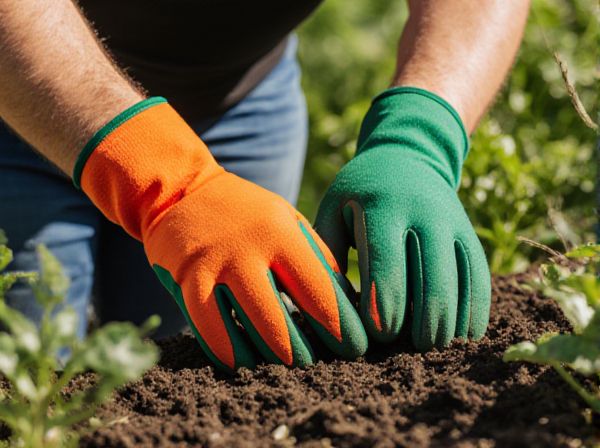
No-Till Gardening vs Tilling Illustration
No-till gardening preserves soil structure and beneficial microorganisms by avoiding soil disturbance, promoting healthier plant growth and reducing erosion. In contrast, tilling breaks up compacted soil but can disrupt microbial communities and increase nutrient runoff. Prioritizing no-till methods enhances soil fertility and supports sustainable, long-term edible garden productivity.
Table of Comparison
| Feature | No-Till Gardening | Tilling |
|---|---|---|
| Soil Health | Preserves soil structure, promotes microbial life, reduces erosion | Disrupts soil structure, reduces microorganisms, increases erosion risk |
| Carbon Sequestration | Enhances carbon storage in soil, mitigates climate change | Releases stored carbon into atmosphere |
| Weed Control | Relies on mulching and cover crops | Mechanical weed removal |
| Soil Moisture | Improves moisture retention | Can lead to faster drying of the soil |
| Labor & Equipment | Less intensive, no heavy machinery needed | Requires heavy machinery and more labor |
| Crop Yields | Often equal or improved over time | Can provide quick initial yield increase |
| Environmental Impact | Reduces soil degradation and pollution | Contributes to soil degradation and pollution |
Understanding No-Till and Tilling Methods
No-till gardening preserves soil structure and microbial life by minimizing disturbance, promoting healthier root systems and increased carbon sequestration compared to traditional tilling. Tilling breaks up compacted soil but can lead to erosion, nutrient loss, and disruption of beneficial organisms, impacting long-term soil fertility. Understanding the balance between no-till and tilling helps optimize soil health and sustainable crop production.
Soil Health: No-Till vs Tilling
No-till gardening preserves soil structure by minimizing disturbance, which enhances microbial activity and promotes nutrient retention essential for healthy plant growth. In contrast, traditional tilling disrupts soil layers, leading to erosion, loss of organic matter, and reduced microbial diversity. No-till methods improve long-term soil health by maintaining moisture levels and fostering a robust ecosystem compared to the short-term benefits of tilling.
Impacts on Soil Microorganisms
No-till gardening preserves soil microorganisms by maintaining soil structure and preventing disturbance of microbial habitats, fostering beneficial bacteria and fungi essential for nutrient cycling. Tilling disrupts microbial communities, leading to decreased microbial diversity, accelerated organic matter decomposition, and impaired soil health. Maintaining a no-till approach promotes a balanced ecosystem, enhances soil fertility, and supports sustainable, long-term agricultural productivity.
Weed Control Strategies Compared
No-till gardening relies on mulch and cover crops to suppress weeds by blocking sunlight and improving soil health, while tilling disrupts weed growth by physically uprooting plants. No-till methods maintain soil structure and microbial activity, reducing weed seed germination over time, whereas tilling can bring dormant weed seeds to the surface, potentially increasing weed pressure. Effective weed control in no-till systems involves consistent mulching and crop rotation, contrasting with frequent mechanical weed removal required in tilled gardens.
Water Retention and Drainage Differences
No-till gardening significantly improves water retention by preserving soil structure and organic matter, reducing evaporation and enhancing moisture availability for plants. In contrast, tilling disrupts soil aggregates, leading to increased water runoff and erosion, which decreases overall water retention. Moreover, no-till practices promote better drainage through enhanced soil porosity and microbial activity, preventing waterlogging and fostering healthier root systems.
Nutrient Cycling and Plant Growth
No-till gardening preserves soil structure and microbial communities essential for nutrient cycling, enhancing the availability of nitrogen, phosphorus, and potassium to plants. In contrast, tilling disrupts these microbial networks, leading to nutrient loss and slower plant growth due to soil disturbance and erosion. Maintaining no-till practices supports improved root development and sustainable nutrient uptake, promoting healthier, more vigorous crops.
Labor and Maintenance Requirements
No-till gardening significantly reduces labor and maintenance by eliminating the need for regular soil turning and minimizing weed control efforts through natural mulch cover. Tilling demands substantial physical effort and frequent soil disturbance, increasing the risk of erosion and nutrient depletion. Gardeners adopting no-till practices benefit from lower maintenance costs and sustainable soil health management.
Environmental Impacts: Erosion and Carbon Sequestration
No-till gardening significantly reduces soil erosion by maintaining soil structure and plant cover, which prevents the loss of topsoil and nutrients. In contrast, tilling disrupts soil layers, increasing erosion risks and releasing stored carbon dioxide into the atmosphere. No-till practices enhance carbon sequestration by promoting organic matter accumulation and soil microbial activity, contributing to climate change mitigation.
Crop Yields and Productivity Outcomes
No-till gardening enhances soil structure, retaining moisture and nutrients, which often leads to higher crop yields compared to traditional tilling. Tilling can disrupt soil organisms and cause erosion, negatively impacting long-term productivity. Studies show no-till methods increase beneficial microbial activity, improving plant health and sustainable crop output.
Choosing the Best Method for Your Edible Garden
No-till gardening preserves soil structure and microbial life, enhancing nutrient retention for edible plants, while traditional tilling aerates soil but can disrupt beneficial organisms. Selecting the best method depends on factors such as soil type, crop requirements, and long-term sustainability goals for your edible garden. Integrating organic mulch and cover crops can complement no-till practices by improving soil fertility and moisture retention.
No-Till Gardening vs Tilling Infographic

 gardendif.com
gardendif.com